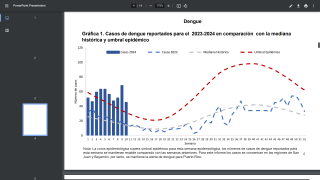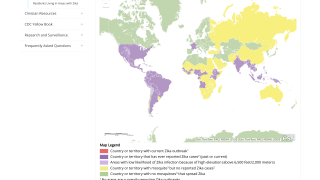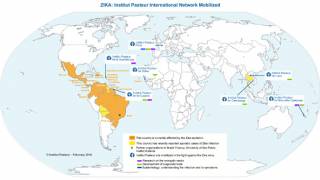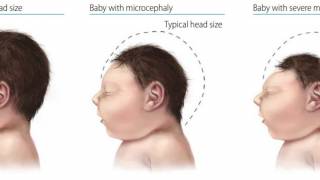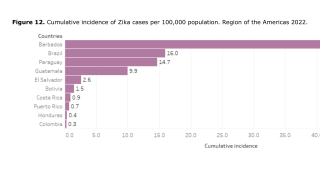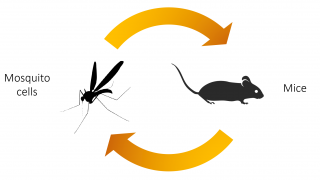Zika-Exposed Children Challenged with Motor Developmental Delays

A recent study found about 32 percent of children born to mothers with probable or confirmed Zika virus infection had below average or poor scores when tested at age 18 months.
This study is important since December 2017, there were about 4,100 pregnant women confirmed with the Zika virus in Puerto Rico.
A Zika virus infection during pregnancy has been associated with adverse birth outcomes known as the Congenital Zika Syndrome (CZS), characterized by microcephaly and central nervous system abnormalities.
However, microcephaly is considered the “tip of the iceberg” of this congenital infection.
Consequently, children with possible congenital Zika infection born with no apparent clinical findings of CZS must be monitored over time.
Luisa Alvarado-Domenech, M.D., with the Ponce Health Sciences University in Ponce, Puerto Rico, said during the November 23, 2019, Session 151 presentation at the American Society of Tropical Medicine & Hygiene, ‘We know the spectrum of disease is much broader, as we have identified infants with microcephaly without brain imaging abnormalities ... and infants without apparent birth defects that have ... developmental delays’ reported MedpageToday.
The Pediatric Outcomes of Prenatal Zika Exposure study follows infants born to mothers with confirmed Zika infection via real-time polymerase chain reaction testing (RT-PCR) or probable Zika infection, defined as a positive IgM result for Zika infection.
This small study found 55 percent of these children were IgM positive, while 45 percent were RT-PCR positive, and about half had asymptomatic infections.
Of these women where infection could be identified by trimester, 14 were infected in the 1st trimester and 10 in the 2nd trimester.
There were 47 infants with Peabody testing, two of which were identified as having moderate microcephaly at birth, but had a normal head circumference range at 18 months.
In addition to the overall Peabody Developmental score, a minority of infants had below-average scores, which is defined as 2 standard deviations below the mean, on the following subtests:
- Stationary subtest (ability to maintain balance): 11% of infants underperformed
- Locomotion subtest (ability to move from one place to another): 21% of infants underperformed
- Object Manipulation subtest (ability to manage a ball): 17% of infants underperformed
Dr. Alvarado-Domenech noted during her presentation ‘that most infants did not have clinically apparent brain defects at birth and that motor development.’
Quantifying and describing the gross motor development of infants that are at risk of gross motor delay and tone abnormalities allows early referrals for developmental interventions and may mitigate adverse impacts of this congenital infection on the development of subsequent skills, concluded abstract 1951.
A previous, related study published in JAMA during January 2019 suggested that although a large proportion of ZIKV-exposed infants without microcephaly develop normally, many do not.
Moreover, the general movement assessment should be incorporated into routine infant assessments by healthcare providers to enable early entry into targeted treatment programs.
The Motor Optimality Score found in this small study was 23 children with normal development, 12 children with adverse outcomes, and 5 children with microcephaly. These researchers concluded this data represents ‘a significant difference.’
And recently, to better coordinate Zika-related research, the Zika Preparedness Latin American Network (ZikaPLAN) was published in October 2019.
ZikaPLAN is a research consortium funded by the European Commission to address the research gaps in combating Zika and to establish a sustainable network with research capacity building in the Americas.
ZikaPLAN`s 15 work packages were designed to address the urgent knowledge gaps to effectively address the problems of ZIKV and build up a research preparedness network in Latin America and the Caribbean region.
A pivotal ZikaPLAN partner is the Global Health Network (TGHN) based at Oxford University, UK. The TGHN is a knowledge-sharing hub that provides capacity building and process improvement through online platforms, regional and online training, resources and professional development to build skills and careers that deliver evidence to change practice.
All publications as a result of ZikaPLAN to date can be found here.
Zika updates published by Zika News
Our Trust Standards: Medical Advisory Committee
- Session 151 - Zika II Abstract
- Association of Infants Exposed to Prenatal Zika Virus Infection With Their Clinical, Neurologic, and Developmental Status
- Characterizing the Pattern of Anomalies in Congenital Zika Syndrome for Pediatric Clinicians
- CDC: Preventing Zika Virus in Puerto Rico: The Provider Role









